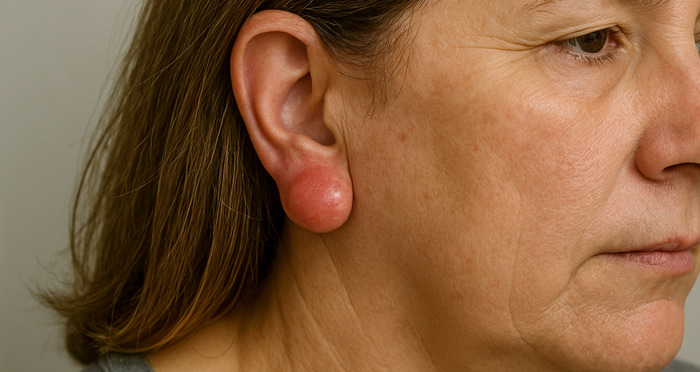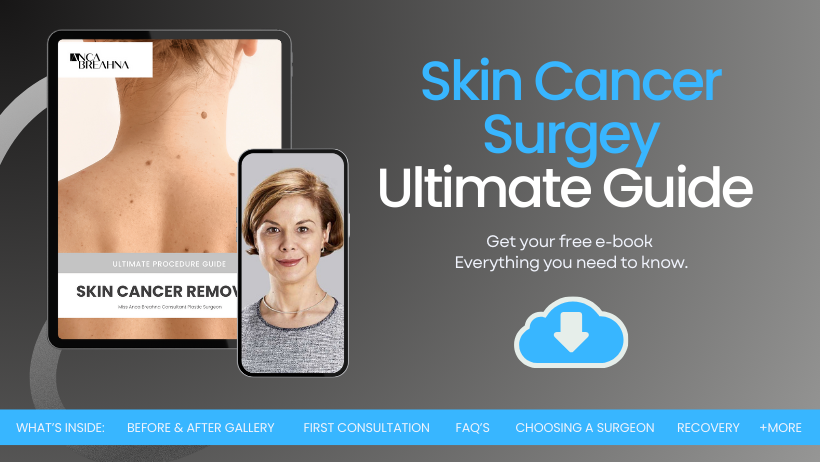
A small bump in the earlobe may seem minor, but for many individuals, it becomes a source of discomfort, irritation, or aesthetic concern. Earlobe cysts are common, generally non-cancerous, and in many cases, easily treated – yet they can cause undue stress if left unaddressed.
Miss Anca Breahna, Consultant Plastic, Reconstructive and Aesthetic Surgeon based in Chester, regularly assists patients who are seeking clarity and treatment for cystic lumps of the earlobe. Through her consultant-led clinic, patients receive expert assessment, precise surgical care, and ongoing support.
Take our Plastic Surgery Quiz to find out if you’d be a good candidate for cosmetic surgery.
This article explains what earlobe cysts are, why they develop, and how removal can help restore comfort and peace of mind.
What Is an Earlobe Cyst?
An earlobe cyst is a closed sac that forms just beneath the surface of the skin, most commonly filled with keratin or sebum. These cysts are typically slow-growing and are considered benign, meaning they are non-cancerous. However, their presences – particularly on the face or ears – can lead to self-consciousness or physical discomfort.
Common features of an earlobe cyst may include:
- Rounded shape: Usually dome-shaped and clearly defined, they may range in size from a few millimetres to over a centimetre.
- Smooth texture: The skin over the cyst is often unbroken and unblemished, making the lump feel soft or rubbery under the surface.
- Mobility: The lump may shift slightly under pressure but remains attached to underlying structures.
- Painless initially: Many cysts are not painful at first but can become sensitive if irritated or infected.
- Central pore or punctum: In some cases, a tiny opening is visible at the centre, where trapped keratin attempts to escape to the surface.
Though generally not dangerous, any new or changing lump should be examined by a medical professional to confirm its nature.
Why Do Earlobe Cysts Develop?
1. Blocked Sebaceous (Oil) Glands
- Natural oil production: Sebaceous glands are responsible for keeping the skin lubricated. If a duct becomes blocked due to inflammation, debris, or trauma, the gland can continue producing oil with nowhere for it to go.
- Trapped keratin or sebum: Over time, this build-up forms a cyst – a firm, encapsulated pocket filled with a soft, cheese-like material.
- Common in oily skin types: People with naturally oilier skin or those who produce excess sebum may be more prone to this type of cyst.
Blocked glands are a leading cause of cyst formation in the earlobe and other facial areas, especially where oil production is higher.
2. Piercing or Trauma
- Introduction of skin cells: Piercing the earlobe may push skin cells deeper than intended, where they become enclosed and begin multiplying.
- Inflammatory response: Piercing guns or improperly sterilised tools can trigger low-grade trauma, leading to swelling, infection, and cyst formation.
- Pressure and friction: Tight earrings, large gauge jewellery, or prolonged use of heavy earrings can stretch or damage the earlobe tissue, increasing the likelihood of blockages or scarring that form cysts.
Piercing-related cysts may appear years after the original piercing and are commonly located adjacent to or directly beneath the piercing site.
3. Skin Conditions
- Acne or folliculitis: Chronic inflammatory skin conditions can obstruct oil ducts or hair follicles, leading to cyst development.
- Seborrheic dermatitis or eczema: Irritated skin is more prone to micro-tears and poor healing, creating an ideal environment for cyst formation.
- Recurring inflammation: Regular inflammation around the ear due to allergies, harsh skincare, or environmental stressors – may also contribute.
These skin conditions may not cause cysts directly but do increase vulnerability to the mechanisms that lead to them.
4. Genetic Factors
- Inherited tendencies: Some individuals may be genetically predisposed to develop cysts, either due to oil gland activity or inherited skin behaviours.
- Associated syndromes: Though rare, certain syndromes like Gardner syndrome include multiple skin cysts as a symptom. These cases often require ongoing monitoring and multidisciplinary care.
- Family history: If one or both parents have experienced cystic skin issues, their children may also be more prone to these benign lesions.
While most cysts are isolated and harmless, Miss Anca Breahna ensures that every patient in Chester receives a personalised assessment to rule out any underlying health concerns.
Download the Skin Cancer Surgery Guide

Signs You May Need an Assessment
Earlobe cysts don’t always require immediate attention. However, certain changes or symptoms suggest that professional review may be necessary.
Warning signs to look for:
- Noticeable increase in size: Rapid growth or continued enlargement over several weeks or months.
- Pain or tenderness: Sensitivity to touch or ongoing discomfort, especially when lying on the affected side or wearing earrings.
- Redness or heat: These may indicate the beginning of an infection or active inflammation.
- Fluid discharge: A white, yellow, or foul-smelling discharge could mean the cyst has ruptured or become infected.
- Recurring swelling: A cyst that drains or shrinks, only to reappear later, may have been incompletely removed or drained without surgical intervention.
- Emotional distress or embarrassment: Even if pain is minimal, patients may seek removal due to the visibility of the lump and its impact on confidence.
In Chester, Miss Anca Breahna provides timely appointments to evaluate earlobe cysts, allowing patients to understand their options and proceed with care suited to their needs.
Can Earlobe Cysts Go Away on Their Own?
- Spontaneous resolution is rare: While some cysts may decrease in size temporarily, the underlying sac typically remains.
- Temporary flattening after rupture: In some cases, a cyst may burst and leak contents. However, if the capsule is not removed, it will likely refill.
- Risk of infection with home treatment: Attempting to squeeze or puncture a cyst at home increases the risk of cellulitis, abscess formation, and permanent scarring.
Self-management often results in further complications, making surgical removal the most effective long-term solution.
Treatment Options in Chester
1. Personalised Assessment
At Miss Anca Breahna’s Chester clinic, the first step is a thorough, one-to-one consultation.
During your assessment:
- Detailed medical history: Including previous cysts, skin conditions, or piercings.
- Physical examination: To determine the cyst’s size, depth, mobility, and relationship to surrounding tissue.
- Diagnosis confirmation: Ensuring the lesion is consistent with a benign cyst and not another type of lump.
- Discussion of goals: Including reasons for removal – comfort, aesthetics, or peace of mind.
Miss Breahna’s consultant-level expertise ensures that no detail is overlooked, and patients receive a clear, individualised treatment plan.
2. Minor Surgical Removal
When removal is indicated, the procedure is:
- Performed under local anaesthetic: Ensuring comfort while avoiding the need for general anaesthesia.
- Minimally invasive: A small incision is made, just enough to remove the cyst and surrounding capsule completely.
- Precise and aesthetic: Miss Breahna uses fine instruments and meticulous technique to minimise scarring and preserve the earlobe’s natural contour.
- Low-risk and efficient: The entire procedure typically takes 15 to 30 minutes, depending on complexity.
Unlike simple drainage, complete surgical excision removes both the cyst and its capsule, dramatically reducing the risk of recurrence.
3. Aftercare and Healing
Following the procedure, aftercare is simple and effective:
- Mild swelling and bruising: Most patients experience minimal swelling that resolves within 3–5 days.
- Suture removal: Stitches are typically removed after 5 to 7 days, depending on healing progress.
- Scar care advice: Patients receive tailored guidance to reduce the appearance of scarring over time, including silicone gel or topical treatments.
- Minimal downtime: Most return to work or daily routines within 24–48 hours, although strenuous activities should be avoided during the first week.
Patients have access to the clinic for any questions or concerns throughout their healing journey.
FAQs About Earlobe Cysts
Can stress or hormonal changes influence the development of an earlobe cyst?
While stress and hormonal fluctuations don’t directly cause earlobe cysts, they can influence oil production in the skin. Increased sebum may contribute to blocked glands, especially if combined with other factors such as irritation or minor trauma. This is more commonly seen in individuals with acne-prone or sensitive skin.
What happens if I leave an earlobe cyst untreated for years?
Some earlobe cysts remain small and unchanged for long periods. However, others may slowly enlarge or become intermittently inflamed. Leaving a cyst untreated increases the chance of it becoming infected, rupturing, or causing structural changes in the earlobe. In rare cases, scar tissue can form around the cyst, complicating future removal.
Is it possible for a cyst to “move” or change position in the earlobe?
Earlobe cysts may feel mobile beneath the skin because they’re often not anchored to deeper structures. While they don’t truly migrate, they can shift slightly with pressure or manipulation. If a lump changes shape, firmness, or mobility significantly, it’s advisable to have it reassessed to confirm it remains benign.
Could this lump be something other than a cyst?
Yes. While earlobe cysts are common, other benign conditions – such as lipomas, keloids, or inclusion cysts – can appear similar. In very rare cases, skin tumours or chronic infections may mimic the appearance of a cyst. A specialist assessment ensures accurate diagnosis and peace of mind.
Are there lifestyle habits that increase the risk of cyst recurrence?
Wearing tight or heavy earrings, sleeping on the same side every night, or using skincare products that clog pores may contribute to cyst development or recurrence. Although recurrence is rare after complete excision, ongoing trauma or irritation to the earlobe should be minimised to prevent new cysts from forming.
What kind of scar can I expect after cyst removal?
Scars from earlobe cyst removal are typically small and fade well over time. Their final appearance depends on factors such as skin type, healing capacity, and adherence to aftercare advice. Miss Anca Breahna uses refined surgical techniques to minimise visible scarring and will provide tailored guidance to support healing.
Will removing an earlobe cyst change the shape of my earlobe?
When performed by an experienced plastic surgeon, earlobe cyst removal preserves the natural contour of the ear. The goal is to remove the cyst entirely while keeping surrounding tissue intact. If the cyst is large or has altered the earlobe’s shape, Miss Anca Breahna may use delicate reconstructive techniques to maintain symmetry and appearance.
Medical References
- Earlobe cyst: Causes, symptoms, and treatment – Medical News Today – https://www.medicalnewstoday.com/articles/321247
- Successful Treatment of Recurrent Earlobe Keloid Through Removal of Underlying Epidermoid Cysts – PMC (PubMed Central) – https://pmc.ncbi.nlm.nih.gov/articles/PMC10546951/
- Giant Earlobe Epidermoid Cyst – PMC (PubMed Central) – https://pmc.ncbi.nlm.nih.gov/articles/PMC3339128/
- Epidermoid cyst of earlobe: a common cyst at an uncommon site – International Journal of Otorhinolaryngology and Head and Neck Surgery – https://www.ijorl.com/index.php/ijorl/article/view/1725
- Posterior Earlobe Mass – American Academy of Family Physicians (AAFP) – https://www.aafp.org/pubs/afp/issues/2018/1115/p603.html
- A Guide to Earlobe Cyst: Causes and How to Treat – Healthgrades – https://resources.healthgrades.com/right-care/skin-hair-and-nails/earlobe-cyst
- Earlobe Cyst: Causes, Treatments, and More – Healthline – https://www.healthline.com/health/earlobe-cyst
Why Choose Miss Anca Breahna for Earlobe Cyst Removal?
Miss Anca Breahna, Consultant Plastic, Reconstructive and Aesthetic Surgeon in Chester, is a trusted provider of skin lesion and soft tissue procedures. Her approach blends clinical excellence with a deep understanding of each patient’s individual needs.
What sets her practice apart:
- Consultant-led care: Every consultation, diagnosis, and procedure is performed by Miss Breahna herself – not delegated to junior staff or assistants.
- Facial expertise: With specialisation in delicate areas such as the head, neck, and ears, Miss Breahna ensures results are both medically effective and aesthetically mindful.
- State-of-the-art setting: Her Chester clinic offers a calm, private, and fully equipped environment for minor surgery.
- Comprehensive follow-up: Aftercare is never an afterthought. Patients receive ongoing guidance and reviews tailored to their specific recovery.
Her reputation throughout Chester and Cheshire reflects her commitment to professional integrity, attention to detail, and individualised patient care.
Next Steps for Patients in Chester
If you are living with an earlobe cyst that’s causing discomfort, changing in appearance, or simply unwanted, you don’t need to wait. Early consultation allows for faster relief, reduced risk of complications, and a discreet solution.
“Each case is unique, and patients deserve accurate information and a calm, respectful environment. I’m here to provide both.” – Miss Anca Breahna, Consultant Plastic, Reconstructive and Aesthetic Surgeon
To book a consultation in Chester, or to learn more about earlobe cyst removal, please visit the website or contact the clinic directly.
Further Reading Related to Earlobe Cyst
- Read more about Cyst Removal Surgery
- Read more about Treatment Options for Lipoma and Other Swellings
- Read more about Skin Procedures
- Read more about Hand Surgery Cheshire
 Ms Anca Breahna, PhD, MSc, FEBOPRAS, FRCS (Plast) is a highly regarded Consultant Plastic Surgeon specialising in the field of Aesthetic and Reconstructive Plastic Surgery. Anca performs a range of
Ms Anca Breahna, PhD, MSc, FEBOPRAS, FRCS (Plast) is a highly regarded Consultant Plastic Surgeon specialising in the field of Aesthetic and Reconstructive Plastic Surgery. Anca performs a range of 